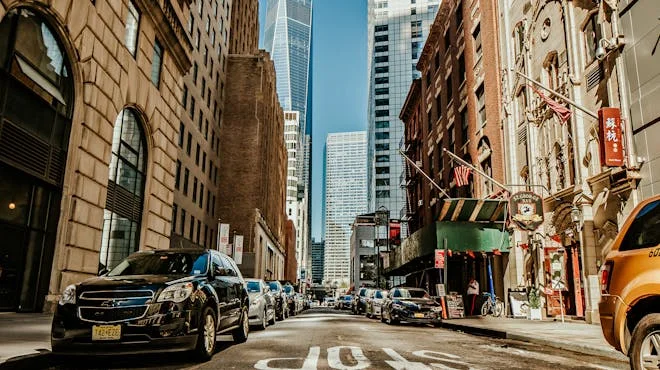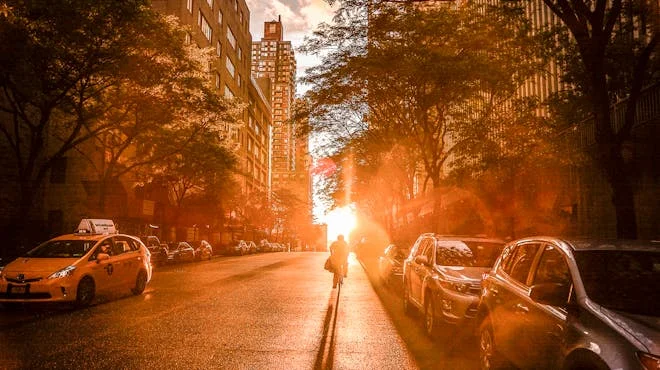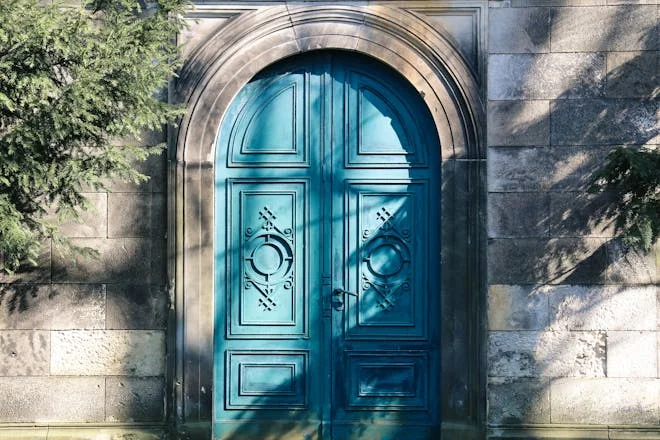
Imagine receiving a letter from a city – not just any city, but the iconic, bustling heart of America: New York City. Today, we’re focusing on a special poem by Elizabeth Bishop called “Letter to NY.” Elizabeth Bishop, renowned for her keen observation and precise language, crafts such a letter in her evocative poem, “Letter to NY.”
In this poetic masterpiece, Bishop invites us to experience the vibrant pulse of New York through her eyes. With each carefully chosen word, she paints a vivid portrait of the city’s sights, sounds, and emotions. Join us, as we analyze the layers of this poem, line to line, and be ready to immerse yourselves in its bustling streets and towering skyscrapers.
Letter to NY By Elizabeth Bishop "For Louise Crane In your next letter I wish you'd say where you are going and what you are doing; how are the plays and after the plays what other pleasures you're pursuing: taking cabs in the middle of the night, driving as if to save your soul where the road goes round and round the park and the meter glares like a moral owl, and the trees look so queer and green standing alone in big black caves and suddenly you're in a different place where everything seems to happen in waves, and most of the jokes you just can't catch, like dirty words rubbed off a slate, and the songs are loud but somehow dim and it gets so terribly late, and coming out of the brownstone house to the gray sidewalk, the watered street, one side of the buildings rises with the sun like a glistening field of wheat. —Wheat, not oats, dear. I'm afraid if it's wheat it's none of your sowing, nevertheless I'd like to know what you are doing and where you are going."
Content
- The Subject and Context of "Letter to NY" by Elizabeth Bishop
- Line-by-line analysis of "Letter to NY" by Elizabeth Bishop
- Themes and recurring ideas of "Letter to NY" by Elizabeth Bishop
- Tone of "Letter to NY" by Elizabeth Bishop
- Form and structure of "Letter to NY" by Elizabeth Bishop
- What literary devices are used in "Letter to NY" by Elizabeth Bishop
- Conclusion
The Subject and Context of “Letter to NY” by Elizabeth Bishop
At its core, “Letter to NY” by Elizabeth Bishop unfolds the relationship between an individual and the bustling metropolis of New York City. Through a letter, the poem explains the multifaceted layers of urban life.
The context of the poem is deeply rooted in poet’s personal experiences and observations of New York City. Bishop spent significant periods of her life living in New York, particularly during the mid-20th century. During this period, New York City was undergoing rapid development and change, emerging as a cultural and economic powerhouse. It was a place of diversity, with people from all walks of life converging in its bustling streets and neighborhoods.
Against this backdrop, Bishop’s poem serves as a reflection on her intimate relationship with the city. It captures the essence of New York’s vibrant energy, its contradictions, and its enduring allure. Through Bishop’s verses, we glimpse the city’s iconic landmarks, from the towering skyscrapers to the bustling avenues, as well as its quieter, more intimate moments.
The narrator of “Letter to NY”
The persona or narrator of the poem is implied to be Elizabeth Bishop herself, as she addresses the city directly in the form of a letter. The narrative unfolds in the second person, with Bishop addressing the city of New York as “you.”
Is the letter addressed to Louise Crane? What is implied by “For Louise Crane” at the beginning of the poem?
It is possible that “Letter to NY” by Elizabeth Bishop could be a letter addressed to Louise Crane. The dedication “For Louise Crane” at the beginning of the poem suggests a personal connection between Bishop and Crane, indicating that the poem may have been written with Crane in mind.
Louise Crane was a close friend of Bishop and a significant figure in her life. She lived primarily in New York City. She was a prominent figure in the literary and cultural scene of the city during the mid-20th century. Crane was known for her support of writers and artists, and she maintained close relationships with many influential figures, including Elizabeth Bishop. While she may have spent time in other locations, such as traveling or visiting friends and family, New York City was her primary residence and the hub of her social and intellectual activities.
Despite these implications, it is also possible that the is not directly addressed to Louise Crane, rather, to someone else close to Bishop, who is living in the city. Therefore, the dedication may serve as a dedication to her friend, expressing Bishop’s gratitude, affection, or acknowledgment of Crane’s influence in relation to the poem. It’s a common practice in literature to dedicate works to individuals who have played meaningful roles in the author’s life or creative process. In this case, Louise Crane likely had a special significance to Elizabeth Bishop, and the dedication serves as a tribute to their friendship and connection.
Line-by-line analysis of “Letter to NY” by Elizabeth Bishop
“In your next letter I wish you’d say”
This line serves as the opening statement of the poem, immediately establishing a sense of longing and anticipation. The use of “wish” conveys a sense of longing or desire, suggesting that the speaker is eagerly awaiting updates or news from the individual being addressed.
This line sets the tone for the rest of the poem, framing it as a heartfelt plea or request for information. It suggests that the speaker feels a sense of distance or separation from the recipient and is seeking reassurance via a letter. The phrase “In your next letter” implies a sense of continuity or ongoing communication, indicating that this is not the first letter the speaker has sent, and that they are hoping for a response in the future.
“where you are going and what you are doing;”
Here, the speaker seeks specifics, expressing a curiosity about the recipient’s activities and whereabouts. This line highlights uncertainty and the desire for clarity or transparency in communication. It also sets the stage for the exploration of the recipient’s experiences and adventures in New York City.
“how are the plays and after the plays”
This line serves as an expression of curiosity and interest in the recipient’s experiences with theatrical productions in New York City. Here, the speaker is seeking details about the plays themselves, as well as the recipient’s experiences and impressions after attending them.
By inquiring about “after the plays,” the speaker is asking not only about the content and quality of the performances but also about the recipient’s reactions and reflections afterward. While this line implies a sense of close friendship they share, it also reflects the speaker’s genuine interest in the recipient’s experiences.
“what other pleasures you’re pursuing:”
The use of the term “pleasures” suggests a broader range of activities beyond just attending plays. It hints at the diverse array of experiences and opportunities for enjoyment available in New York City. By inquiring about “other pleasures,” the speaker is inviting the recipient to share details about their personal interests, hobbies, and recreational activities. This broadens the scope of the conversation beyond just theater.
“taking cabs in the middle of the night,”
Bishop employs imagery to evoke the experience of late-night cab rides in New York City. The image of taking a cab in the middle of the night suggests a sense of adventure and spontaneity, as well as the bustling nightlife of the city.
“driving as if to save your soul”
This metaphorical expression suggests a sense of intensity in the act of driving. The phrase “save your soul” implies a deeper significance or purpose behind the action. Furthermore, this metaphor can also carry a deeper meaning hinting at navigating oneself or self-transformation, as an adaptation to keep up with the buzzling city life.
“where the road goes round and round the park”
Bishop utilizes imagery to depict the circular motion of driving around a park in New York City. This line conveys a sense of repetition or monotony, as well as the cyclical nature of urban life. It also suggests a sense of disorientation or confusion in navigating the city streets.
“and the meter glares like a moral owl,”
Here, Bishop employs personification to imbue the meter of the cab with human-like qualities. The simile “like a moral owl” suggests a sense of judgment, as if the meter is watching or assessing the actions of the passengers. This line introduces a touch of whimsy and humor to the poem.
Furthermore, the comparison to an “owl” adds a layer of symbolism to the line. Owls are often associated with wisdom and knowledge in literature and folklore. Moreover, their nocturnal nature evokes a sense of mystery and darkness. By comparing the meter to an owl, meter is brought forward as an observer of the city’s nighttime activities. It further highlights the active night life of New York city.
“and the trees look so queer and green”
Again, Bishop utilizes imagery to depict the quality of the cityscape at night. In urban environments like New York City, trees are often planted along sidewalks, in parks, and in other green spaces to provide shade, improve air quality, and enhance the aesthetic appeal of the city. These trees may appear somewhat different from those found in more natural or rural settings due to factors such as pollution, limited space for root growth, and the presence of artificial light.
The word “queer” in this context does not necessarily refer to sexuality but rather to something that is unusual, peculiar, or different from the norm. In describing the trees as “queer,” the speaker conveys that somehow, she finds them unusual or striking in some way. This could be due to their appearance, such as unique species or shapes. The words “so” “green” infer the vivid colours of the trees, as if they look too green.
Additionally, green is often associated with growth, vitality, and nature, juxtaposing the artificiality of the urban environment. By highlighting the color green, the speaker draws attention to the growth in the city life, in the midst of its man-made elements.
“standing alone in big black caves”
This metaphorical expression of the city streets resembling “black caves,” suggests confinement or isolation. The image of the trees standing alone amidst the darkness reinforces the theme of solitude in the urban landscape. Moreover, the speaker uses enjambment, from one line to the next, adding a continuity and flow to the letter.
“and suddenly you’re in a different place”
Here, the speaker describes a sudden shift, where the familiar surroundings of the cityscape give way to something new and unexpected. This line suggests that New York City has the power to transport individuals to “a different place,” both physically and emotionally. Additionally, it implies the city’s diverse neighborhoods, vibrant culture, and the adventurous nature of night life.
Additionally, the phrase “a different place” may also carry symbolic significance, suggesting a departure from the ordinary aspects of daily life.
“where everything seems to happen in waves,”
Here, Bishop employs imagery to depict the ebb and flow of activity in the city. The metaphor of “waves” suggests a movement or fluctuation, as well as the dynamic energy of urban life.
“and most of the jokes you just can’t catch,”
Here, Bishop employs hyperbole to exaggerate the difficulty of understanding jokes or humor in the city. It suggests that New York City can be a place of rapid and complex interactions. Additionally, the phrase “you just can’t catch” implies a sense of frustration.
Furthermore, the inability to “catch” the jokes may symbolize a broader sense of alienation or isolation experienced by the speaker within the urban landscape. In a city as diverse and fast-paced as New York, individuals from different backgrounds and experiences may struggle to fully connect or engage with one another, leading to moments of misunderstanding or miscommunication.
“like dirty words rubbed off a slate,”
This simile compares nature of jokes to “dirty words rubbed off a slate.”. It evokes the image of words written on a slate board being erased or wiped away, leaving only faint traces or remnants behind. The comparison suggests that the jokes or humor encountered in the city may be transient, quickly fading from memory or losing their impact over time.
Furthermore, the use of “dirty words” in the simile adds a layer of complexity to the imagery, implying that the jokes or humor may carry a sense of disrespect or edginess. This could reflect the diverse and sometimes provocative nature of humor within the city, where individuals may push boundaries or challenge social norms in their interactions.
“and the songs are loud but somehow dim”
Bishop utilizes juxtaposition to convey the sensory experience of hearing loud music in the city. The contrast between “loud” and “dim” suggests a sense of distortion, as well as the overwhelming nature of urban noise.
“and it gets so terribly late,”
This line emphasizes the passage of time and the late-night hours spent in the city. It conveys exhaustion or weariness, as well as the relentless pace of urban life. This line also serves as a transition to the next stanza, signaling a shift in the poem’s focus.

“and coming out of the brownstone house”
Here, the speaker uses imagery of an individual emerging from a brownstone house, a type of residential building commonly found in the city. Brownstone houses are characterized by their distinctive brownstone facades, which lend them a sense of historic charm and architectural significance. They are often associated with certain neighborhoods in New York City, particularly in areas like Brooklyn and Manhattan.
The mention of a brownstone house brings about a familiarity with the city, as it is a classic feature of the urban landscape. It also suggests a connection to the city’s history and heritage, as brownstone houses are often emblematic of New York’s rich architectural legacy. Furthermore, the act of “coming out” of the brownstone house implies detachment from traditional norms. Hence, it captures a moment of everyday life in New York City, amidst the sounds of the bustling streets and neighborhoods.
“to the gray sidewalk, the watered street,”
The use of the word “gray” to describe the sidewalk, lacking the vibrancy or color. Additionally, “gray” may also symbolize the monotony or sameness of city life, highlighting the routine and everyday nature of the speaker’s experiences.
Meanwhile, the description of the street as “watered” adds a layer of texture and sensory detail to the scene. The term “watered” suggests that the street has been recently wetted or moistened, perhaps by rain or street cleaning. This imagery conveys a sense of freshness or cleanliness, contrasting with the “gray” sidewalk and adding depth to the overall description of the urban landscape.
“one side of the buildings rises with the sun”
Here, the speaker observes the effect of the rising sun on the buildings, specifically noting that “one side” of them appears to be illuminated by the sunlight. It suggests a sense of contrast or asymmetry within the cityscape, as only one side of the buildings is touched by the sun’s rays while the other side remains in shadow. Thus, this contrast between light and shadow reflects the dynamic and ever-changing nature of the urban environment.
Furthermore, the mention of the sun rising symbolizes a new beginning or fresh start, suggesting the promise of a new day in the city. It conveys a sense of optimism and hope. Additionally, the sun’s ascent contrasts with the darkness and uncertainty of the urban night.
“like a glistening field of wheat.”
This line provides a vivid comparison of the visual effect created by the sunlight on one side of the buildings to a “glistening field of wheat.” Ironically, it is evoking imagery of a rural landscape bathed in sunlight. Additionally, this simile implies warmth, radiance, and abundance.
“—Wheat, not oats, dear. I’m afraid”
This parenthetical remark interrupts the flow of the poem, adding a touch of intimacy or familiarity to the speaker’s address. The use of the term “dear” conveys a sense of affection or endearment. The hyphen stresses the use of the two cereals as a metaphor. Here, the distinction between “wheat” and “oats” contrasts elements of rural and urban life.
“Wheat” is commonly associated with rural landscapes and agricultural settings. It symbolizes fertility, abundance, and sustenance. Wheat fields evoke images of open expanses of land, natural beauty, and the rhythms of rural life. By referencing wheat, the speaker may evoke a sense of nostalgia for the simplicity and wholesomeness of rural existence, contrasting with the complexity and pace of urban life.
In contrast, “oats” are also a cereal grain but are often associated with more practical purposes, such as animal feed or breakfast cereal. While oats can also be grown in rural areas, they are not as strongly associated with the idyllic imagery of wheat fields. In the context of the poem, the speaker shows preference to wheat as opposed to oats, despite the practice of the recipient.
“if it’s wheat it’s none of your sowing,”
This line extends the metaphor of the field of wheat. In this line, the speaker is essentially stating that if the scene described earlier in the poem indeed resembles wheat, it is not something that the recipient has directly contributed to or influenced. The use of the phrase “none of your sowing” suggests that the recipient has not played a role in planting or cultivating the metaphorical wheat field depicted in the urban landscape.
This line could have several layers of meaning. First, it highlights the recipient’s passive role as an observer rather than an active participant in shaping the urban landscape. Usually in the rural setting, individuals actively participate in cultivation to wheat fields.
However, the scenery is urban cities do not have such an intimacy or connection to anybody dwelling in it. Second, the beauty and vitality of the city as symbolized by the wheat field, are beyond individual control or influence. Thus, the line serves as an important statement to imply the level of connection of city dwellers to the city environment, despite its vibrant nature.
“nevertheless I’d like to know”
The use of the term “nevertheless” suggests willingness to engage in dialogue despite differences or misunderstandings. Here, the speaker expresses a desire for understanding or connection, reinforcing the theme of communication that runs throughout the poem.
“what you are doing and where you are going.”
The poem concludes with a repetition of the speaker’s initial inquiries, emphasizing the theme of curiosity and the desire for information or insight. This closing line serves as a reminder of the speaker’s longing for connection and communication, as well as a plea for openness and transparency in their relationship.
Check out this beautiful video of Helena Bonham Carter giving a lovely presentation of the poem “Letter to NY” by Elizabeth Bishop. Helena Bonham Carter reads ‘Letter to NY’ by Elizabeth Bishop for A Poem for Every Autumn Day (youtube.com)
Themes and recurring ideas of “Letter to NY” by Elizabeth Bishop
The main theme of “Letter to NY” revolves around the experience of urban life. The poem delves into the unique sensations and challenges of living in a vibrant city like New York. Bishop portrays the city as a dynamic and ever-changing environment, filled with both excitement and uncertainty.
Other themes explored in the poem
Isolation and Alienation: Amidst the hustle and bustle of city life, the poem also has a sense of isolation and disconnection. Bishop captures the loneliness of the urban landscape, where even simple pleasures can feel inaccessible.
Communication and Connection: The desire for communication and connection runs as a thread throughout the poem. Bishop longs for updates from the recipient of the letter, expressing a yearning for understanding and intimacy in their relationship.
Cultural Exploration: The poem touches upon the cultural richness and vibrancy of New York City. Bishop employs vivid sensory imagery to evoke the sights, sounds, and sensations of the cityscape. From late-night cab rides to the glistening dawn, the poem immerses readers in the sensory richness of urban existence.
Time and Transition: Throughout the poem, there is a subtle exploration of time and transition. Bishop reflects on the passage of time, the fleeting nature of experiences, and the inevitability of change in the urban landscape.
Tone of “Letter to NY” by Elizabeth Bishop
The tone of the poem is one of nostalgia and wistful reflection. Throughout the poem, the speaker reminisces about the experiences in New York City. Despite moments of humor and whimsy, there is an underlying melancholy in the poem, reflecting the speaker’s feelings of isolation and disconnection amidst the bustling cityscape.
Form and structure of “Letter to NY” by Elizabeth Bishop
Elizabeth Bishop’s “Letter to NY” consists of five stanzas, each consisting of four lines. It is punctuated with commas and periods, but there is a notable scarcity of other punctuation marks such as semicolons or exclamation points. This lack of punctuation enhances the conversational tone of the poem, allowing the lines to flow seamlessly from one to the next. It also invites readers to pause and reflect at the end of each line or stanza, creating a sense of rhythm and musicality.
Rhyme scheme and rhythm
In terms of rhyme scheme, “Letter to NY” does not adhere to a strict pattern. While there is no consistent rhyme scheme, Bishop occasionally incorporates slant rhymes or near rhymes to create subtle echoes and connections between words. Moreover, in most stanzas, the second and fourth lines exhibit a rhyme, contributing to a loose ABAB rhyme scheme.
However, these rhymes are not rigidly structured or consistent throughout the poem, reflecting the organic and unpredictable nature of urban existence. The lack of a strict rhyme scheme allows Bishop to focus on other poetic devices, such as imagery and metaphor, to convey the themes and emotions of the poem.
What literary devices are used in “Letter to NY” by Elizabeth Bishop
Metaphor: Bishop utilizes metaphor to convey complex ideas and emotions. For example, city streets resembling “black caves,” suggests confinement or isolation.
Simile: The poem also features similes, such as “and the meter glares like a moral owl,” and jokes “like dirty words rubbed off a slate.”
Personification: Bishop personifies objects and elements of the urban landscape, such as the taxi meter described as a “moral owl,” and the trees “standing alone.”
Imagery: Rich, vivid imagery is a hallmark of Bishop’s poetry, and “Letter to NY” is no exception. The poem paints detailed pictures of urban scenes and sensations, inviting readers to visualize the city streets, parks, and buildings described within.
Repetition: Bishop uses repetition strategically throughout the poem to emphasize key themes and ideas. For instance, the repetition of the phrase “where you are going and what you are doing” underscores the speaker’s longing for communication and connection.
Enjambment: The poem frequently employs enjambment, where lines of verse extend beyond the confines of individual stanzas. This technique creates a sense of fluidity and movement, mirroring the speaker’s train of thought as they reflect on their experiences in New York City.
Rhyme: As previously mentioned, “Letter to NY” features a loose rhyme scheme, with the second and fourth lines of each stanza often rhyming with each other.
Symbolism: Certain elements within the poem, such as the rising sun described as “like a glistening field of wheat,” carry symbolic significance. The sun’s ascent symbolizes renewal and hope, contrasting with the darkness and uncertainty of the urban night.

Alliteration: Bishop occasionally employs alliteration, where the repetition of consonant sounds creates a musical effect and draws attention to specific words or phrases. An example can be found in the line “and most of the jokes you just can’t catch,” where the repeated “j” sound emphasizes the difficulty of understanding humor in the city.
Irony: The poem subtly incorporates irony, particularly in lines such as “and the songs are loud but somehow dim,” where the juxtaposition of loudness and dimness creates a sense of contradiction or paradox within the urban environment.
Conclusion
In “Letter to NY” by Elizabeth Bishop, the narrator writes a heartfelt letter to a friend or loved one, expressing curiosity and concern about their well-being and activities in New York City. The poet’s intention appears to be to reach out and maintain a connection with the recipient, despite physical distance. Reading the poem may evoke feelings of empathy and nostalgia, as well as a sense of connection to the universal themes of urban life, friendship, and longing.
To read more of our poem reviews, please visit Life – PoemRead
RELATED POSTS
View all



